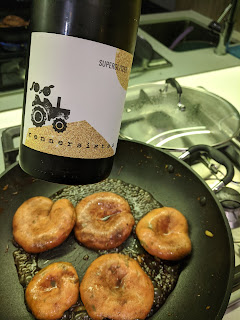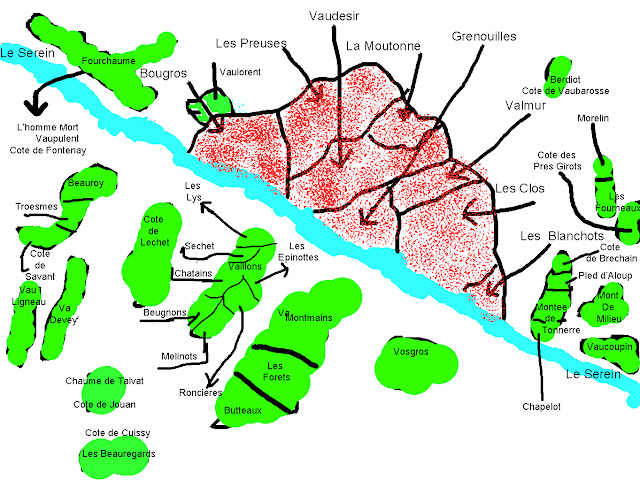Bottles during Lock down WINE - SAKE - BEER
It has been an incredible time, with this restriction COVID 19 at home, we learn how to be more confident with the kitchen and as well each dish I prepared with my wife we did drunk lots of wines; my cellar here in Melbourne is becoming empty.
Hopefully, this restriction will be lifted in all their limitation, and we can go back to normality soon. Traveling in the vineyards, visit the producer and meet peoples in the wine bar and restaurant are the things more I missed.
Here some wines I have been enjoying during this time:


Hopefully, this restriction will be lifted in all their limitation, and we can go back to normality soon. Traveling in the vineyards, visit the producer and meet peoples in the wine bar and restaurant are the things more I missed.
Here some wines I have been enjoying during this time:


Rennersister Two sisters, Susanne and Stefanie, a natural winemaking in Austria, Burgenland region. A family winery since 1988 and the sisters are now taking in charge step by step. 2015 was the first vintage for red and white wines – so Rennersistas was born. 12 hectares surroundings their hometown, Gols. All their vineyards and wines are certified biodynamic and they’re worked with lots of intensive manual care. With the help of mother nature, healthy soils are the focus on making honest wines that express themselves.
2018 SUPERGLITZER Zweigelt, St Laurent, Rösler, and Blaufrankish a very savory wine, with this core of acidity refreshing the palate with every sip. Dark fruit and savory earthy as umami mushroom Shiitake and porcini. Tannins are very Bojo type with this refreshing drinkability. 12%
2018 SUPERGLITZER Zweigelt, St Laurent, Rösler, and Blaufrankish a very savory wine, with this core of acidity refreshing the palate with every sip. Dark fruit and savory earthy as umami mushroom Shiitake and porcini. Tannins are very Bojo type with this refreshing drinkability. 12%
15kms off the coast of Tuscany lies the small island of Giglio (population 600) where Francesco Carfagna, his wife Gabriella and his daughter Irene live and make wine. A popular tourist island in the summer, Francesco has been doing his family holiday on the Giglio island from Rome since he was a young child, and in 1985 decided it was time to leave the fast-city life and move to the island he had fallen so in love with all those years ago. In his first summer on the island since moving, he found another type of love when he met his wife Gabriella and in 1987, they opened a restaurant called Arcobaleno serving simple food and artisan wines. They ran the restaurant until 1999 when they found some abandoned vines and terraces and set out to restore them. Altura the name directly translates to “wild, high altitude location”, and the vineyards are situated on a granitic terraced 200m above sea-level over the Tyrrhenian Sea. All the work in the vineyard is done by hand as the vines are inaccessible by vehicle or tractor. Most of the vines are of the ancient grape variety Anosonaco which use to be planted all over the island but in recent times have either been abandoned or uprooted. Francesco has also planted some massale selections of red varieties such as Sangiovese, grenache and a mix of local ancient varieties from old vines planted on the island. After ten years working to restore the terraces and get the 3.5 hectares of vines into healthy order, they made their first vintage in 2009. There has never been any use of herbicides or insecticides in the vineyard and only when needed there are low treatments of sulfur and copper. The vines are extremely low yielding and facing the sea unforgiving landscape. However, this gives the grapes incredible concentration and an undeniable saline minerality. Once the grapes are carted along the steep cliffs, vinification happens in the basement of an ancient grain mill that the Carfagnas have now converted into their home. The wines usually spend a few days on skins before being pressed, then racked off their gross lees into stainless steel vats for fermentation and transferred to old barrels for aging. The wines are never fined or filtered.
2017 Altura Ansonaco The wine is orange in color with this nice grippy tannin which needs some food, the nose is wide and full of candied stone fruit and preserved cured salty element, quite powerful in the palate with this refreshing acidity and lightly punching tannin. Salty and sea reminiscent. 13,5%
2017 Altura Ansonaco The wine is orange in color with this nice grippy tannin which needs some food, the nose is wide and full of candied stone fruit and preserved cured salty element, quite powerful in the palate with this refreshing acidity and lightly punching tannin. Salty and sea reminiscent. 13,5%
Considered one of Catalunya's natural wine pioneers, Laureano Serres turned his back on the huge boom of conventional wine in Catalunya during the 90s. Laureano is one of the biggest advocates for natural wines in Spain. He is a pioneer in producing natural wines, using natural techniques both in the vineyard and at the winery, with no chemical products being used at any stage of production.He started out in his own cellar in El Pinell de Brai (Tarragona, Catalunya, Spain), and makes a large range of wines with nothing added at all. Serres works 6 hectares of low yielding vines, and he has a small cellar which is under his home in the village. He has a profound influence on Spanish natural wine, opening the path for a new generation of Catalan natural winemakers. Laureano now works at least 3 parcels of vines in and around Terra Alta, including family holdings at Finca Abeurador (Macabeo), Terme de Guiu (Carinyena and Macabeo), and Finca Caibelles (assorted local and Bordeaux varieties). At the same time, he pitches in with a handful of like-minded neighbors with whom he makes occasional collaborations. Laureano has settled into a unique methodology of cellar work that is at once revolutionary and conservationist. On the one hand, certain parcels are vinified in the “traditional” manner as single-vineyard Cuvee. Reds are macerated and whites are pressed directly with most Elevage taking place in stainless steel. He is experimenting with fermentation in assorted vessels such as amphorae and barrel, often assembles different Cuvees, and tests out new ideas about Elevage.
2018 Terme de Guiu la plans (m)Macabeo from a young vineyard planted 470 meters above sea level. Elevage in 200-liter amphora for a few months. God rich color, citrus and spice on the nose with elderflower and infused raspberry petals, light bitter on the finish, long persistence and very horizontal on the palate was able to stand and pairing a lamb rack 13,2%
2018 Terme de Guiu la plans (m)Macabeo from a young vineyard planted 470 meters above sea level. Elevage in 200-liter amphora for a few months. God rich color, citrus and spice on the nose with elderflower and infused raspberry petals, light bitter on the finish, long persistence and very horizontal on the palate was able to stand and pairing a lamb rack 13,2%

The company Corvagialla is located in an area near the Bolsena lake on the border between Lazio and Umbria, was founded in 2007 around a small house surrounded by four hectares of land, in a place overlooking the "Land of Alta Tuscia". In the Upper Tuscia in the countryside of Viterbo, the soil is volcanic origin rich in nutrients that strongly characterize the aromas of the wine. Varieties from the areas are Sangiovese, Ciliegiolo for the reds and Grechetto, Trebbiano, and Vermentino for the whites. In addition to the vines there are olive trees, and then a vegetable garden, fruit trees, hens, geese, goats, and donkeys. In the vineyard the grapes are grown without the use of herbicides, fertilizers, and chemical treatments, the harvest is done by hand by checking each bunch. Fermentation in the cellar takes place with only sulfur dioxide produced naturally from grapes and any intervention is done even after fermentation.
2016 Rosso Delle Grotte100% Sangiovese, bright feminine Sangiovese ruby color very alive and translucent. Noce of tar and infused rose petal along with morello cherry and volcanic minerality. Lots of tension in the palate but the mainly earthy character coming on the taste, in the mouth the Sangiovese is less oriented, is more Bolsena style of wine. 13%
In the prefecture of Shiba just two-hour drive from Tokyo.
Terada Honke owns 2 hectares of land and they grow their own rice without pesticide and herbicide the rice varieties are Kameno-o, Shinriki, and Chiba Nishiki varieties. They also have some local farms growing rice for them; which they all organic farming, like rice duck farming a method where ducks are freed in the rice fields, to let them eat the weeds and the bugs.
A Tedara Honke all the rice is hand-washed. He also made their own Koji-kin the starch converting mold Aspergillus Oryzae.
This Cuvee is Bodai Moto pre-modern and ancient technique of sake making:
You can consider it a pre-cursor to the Kimoto method which was invented in the Edo period. Nowadays, it is very rare, but some sake is still made using this method. To create Bodai-moto, raw rice, and a bit of steamed rice are left to soak in a small tub with water. While soaking, this water becomes rich in natural lactic acids given off by lactic acid bacteria. After about three days, the rice is removed from the water and steamed. Next, in the Moto tank, the Latic acid-rich water is mixed with the steamed rice, some koji rice and yeast to create the moto. The lactic acid in the water kills wild yeast and stray bacteria in the moto and allows the sake of yeast to propagate without much microbial competition.
2019 Bodai Moto Tedara Honke
crispy, lemony, and super fresh with umami and yuzu rind. Very easy to drink and very palatable.
Lots of acidity and tension on the mouth. This yuzu and yeasty flavour are the main thing I was able to detect we had this Parmiggiano Reggiano Vacche Rosse "Red Cow" 3 years old.
The domain of Francois Blanchard is located in Touraine AOC in the Loire Valley.
The farm consists of a single plot of 2.74 ha "Le Grand-Cléré" and controlled by ECOCERT SAS (body of control on the respect of the rules of the organic production method, approved by the Ministry of 'Economy and the Ministry of Agriculture).
Boisson Sauvage is a spontaneous fermentation beer made by him in 2019 is very similar to a Lambic beer with those fantastic lactic bretty elements. We paired with Bolognese curry spaghetti. 5%
Best
raffaele mastrovincenzo
wine / spirit / lambic / drinker
Melbourne Abruzzo
https://www.instagram.com/pitbeat/







Aprobceaplac_te Rob Farley link
ReplyDeletemucpewanbo